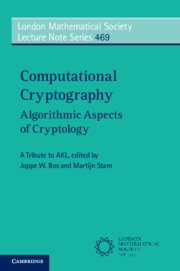Book contents
- Frontmatter
- Contents
- List of Contributors
- Preface
- 1 Introduction
- Part I Cryptanalysis
- 2 Lattice Attacks on NTRU and LWE: A History of Refinements
- 3 History of Integer Factorisation
- 4 Lattice-Based Integer Factorisation: An Introduction to Coppersmith’s Method
- 5 Computing Discrete Logarithms
- 6 RSA, DH and DSA in the Wild
- 7 A Survey of Chosen-Prefix Collision Attacks
- Part II Implementations
- References
- Index
4 - Lattice-Based Integer Factorisation: An Introduction to Coppersmith’s Method
from Part I - Cryptanalysis
Published online by Cambridge University Press: 11 November 2021
- Frontmatter
- Contents
- List of Contributors
- Preface
- 1 Introduction
- Part I Cryptanalysis
- 2 Lattice Attacks on NTRU and LWE: A History of Refinements
- 3 History of Integer Factorisation
- 4 Lattice-Based Integer Factorisation: An Introduction to Coppersmith’s Method
- 5 Computing Discrete Logarithms
- 6 RSA, DH and DSA in the Wild
- 7 A Survey of Chosen-Prefix Collision Attacks
- Part II Implementations
- References
- Index
Summary
In Chapter 4, Lattice-Based Integer Factorisation: An Introduction to Coppersmith’s Method, Alexander May investigates the use of LLL to factor integers as pioneered by Coppersmith. Conceptually, Coppersmith’s method can be deceptively simple: given additional information about an integer to factor (e.g., the knowledge that an RSA key pair (N; e) has a small corresponding private exponent d), derive a system of equations with a small root that reveals the factorization and use LLL to find the small root. As a result, it becomes possible to explore exponentially sized search spaces, while preserving polynomial time by using the famous LLL lattice reduction algorithm. Yet, exploiting Coppersmith’s method in a cryptographic context optimally often involves a number of clever choices related to which system of equations to consider. At first, this is a tantalisingly annoying problem where the choice may appear obvious only in retrospect. May uses his extensive experience in improving the state of the art to explain the reasoning behind various applications in Chapter 4.
Keywords
Information
- Type
- Chapter
- Information
- Computational CryptographyAlgorithmic Aspects of Cryptology, pp. 78 - 105Publisher: Cambridge University PressPrint publication year: 2021
Accessibility standard: Unknown
Why this information is here
This section outlines the accessibility features of this content - including support for screen readers, full keyboard navigation and high-contrast display options. This may not be relevant for you.Accessibility Information
- 3
- Cited by
